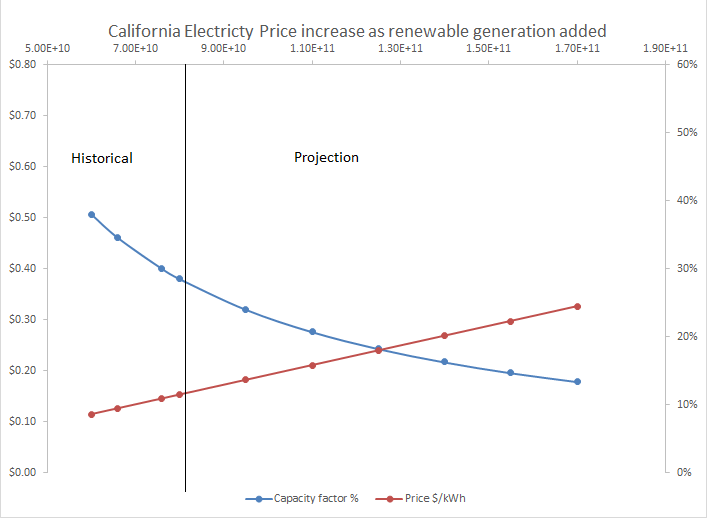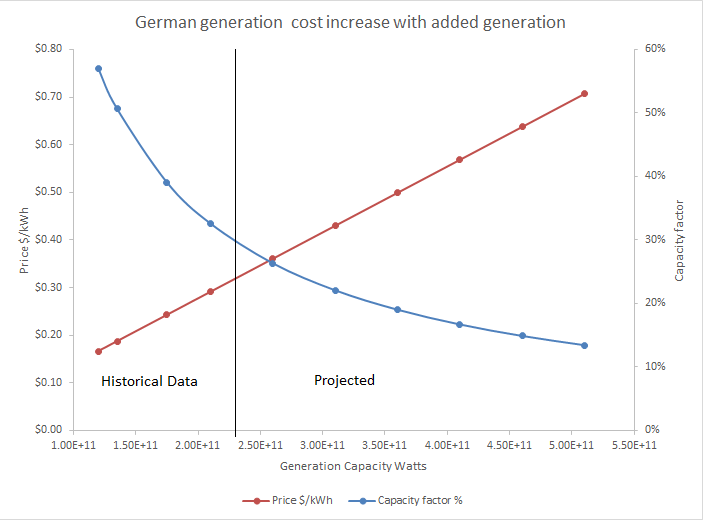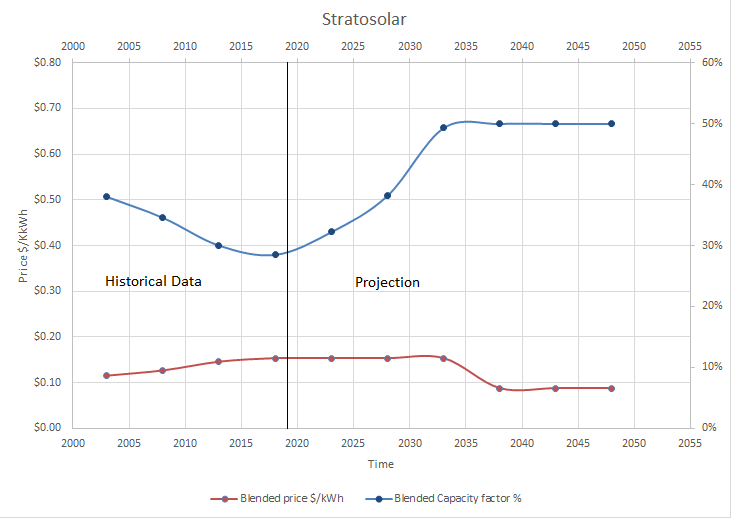|
It is becoming an accepted part of the current energy/climate narrative that renewable energy electricity generation from solar and wind has become economically competitive with fossil fuel generation. So if this is true why are renewables not growing and supplanting fossil fuels? Because wind and solar are relatively new and only account for a small part of overall generation there is little data to inform the debate which largely relies on theoretical solutions with lots of assumptions. Rather than a bottom up theoretical model that tries to estimate and sum unknown costs there is a simpler macro level approach that uses real total system data, does not make lots of assumptions and inherently includes all costs. The price of electricity is determined by the overall cost of generation, transmission, distribution operation and maintenance. Most of the cost is capital cost. Utilities use the revenue from selling electricity to repay the loans used to build the capacity. Revenue to pay capital costs is heavily dependant on capacity factor, the ratio of average output to nameplate peak output. There are two large markets, Germany and California where there is significant renewable generation in the region of 20% to 30%. Both markets are representative of the overall market and have historical data on overall generation capacity, actual generation and average price of electricity to customers. Dividing overall generation by overall generation capacity gives overall capacity factor. The graphs below show the resulting capacity factor along with the average electricity price to customers for both markets. The historical data is on the left and projected capacity factor and price are on the right. Both markets show the same behavior. Capacity factor has fallen as renewable generation was added and existing generation was still needed as backup. As capacity factor has fallen electricity price rose. A simple model that calculates the price as a constant for each market divided by the capacity factor closely matches the price rise curve. As California capacity factor has fallen from 41% in 2000 to 29% today, price has risen from $0.10/kWh to $0.16/kWh, a 60% increase. The US national average electricity price has remained constant at around $0.10/kWh. California has expensive electricity by US standards. Projecting forward to full renewable energy, capacity factor falls from 29% to 13% as generation capacity,storage capacity and transmission capacity are added and legacy fossil fuel capacity cannot be retired because of long duration intermittency. This results in electricity price rising to over $0.32/kWh, over three times the price for US regions without renewable energy. Over a similar period, as German capacity factor fell from 57% to 33%, the electricity price rose from 16 cents to 29 cents. Projecting forward, capacity factor falls to 13% as price rises to over 70 cents, over four times its price in 2000. German capacity factor is better than California mainly because California has a lot more hydro-electricity which has a low capacity factor and very high multi year intermittency due to droughts. The German price is higher than California because of high taxes and the use of feed in tariffs paid by electricity customers to subsidize renewables. So despite lower generation costs for renewables, the price of electricity is rising because of the rising overall capital costs needed to accommodate them in the grid. The costs are high and already are getting pushback in Germany. Germany's renewable energy growth has slowed and along with resistance to higher prices, NIMBY forces that object to windmills and transmission lines have curtailed growth. High prices in California are not raising political headwinds yet but as prices continue their inexorable rise it is likely that there will be political pushback. Nobody is telling customers that the price for electricity will at least double as we try to meet our 100% renewables goal. High electricity prices have economic consequences if your competitors have prices one third your level. California is rich, but the bulk of the world building new electricity generation is poor and developing. They cannot burden their economy with such high priced electricity. Current intermittent wind and solar cannot escape this increasing price. An acceptable renewable energy solution needs a lower price than fossil fuels. That is where Stratosolar comes in. Without long term intermittency Stratosolar can eliminate the legacy generation and its high capacity factor provides much cheaper generation. The following graph shows price trends for a stratosolar solution for California. Prices stabilize at around $0.15/kWh while capacity factor grows and the legacy generation is phased out. Then capacity factor stabilizes at around 50% and prices fall to around $0.08/kWh. Stratosolar cost of generation is low but this price includes generation, transmission, distribution, storage and operational costs for California. The contrast is stark. With current wind and solar, prices will rise continuously for the foreseeable future. With Stratosolar prices will cease growing and fall below current levels for fossil fuels. This economic story is not understood or accepted but the evidence from Germany and California is there for all to see. A solution that imposes economic hardship on those least likely to afford or accept it is doomed to failure no matter how noble the cause.
By Edmund Kelly
Comments
|
Archives
December 2023
Categories
All
|
|
© 2024 StratoSolar Inc. All rights reserved.
|
Contact Us
|




 RSS Feed
RSS Feed